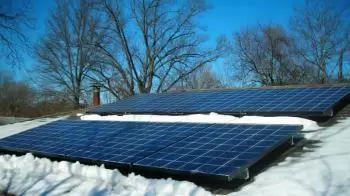
Hybrid solar panels are devices that combine photovoltaic and thermal solar energy. From them you can obtain electricity and heat at the same time. That is, a PVT panel is capable of generating electrical energy and hot water.
Therefore, a hybrid solar panel is composed of a photovoltaic collector to which a heat exchanger is associated. This exchanger is capable of heating a fluid thanks to the part of solar radiation not converted into electrical energy.
What is a hybrid solar panel for?
A hybrid solar panel allows you to generate electricity and hot water.
In the same solar panel installation, hybrid panels act both as photovoltaic solar panels and thermal panels. In this way, solar energy can be used to heat water and increase the efficiency of electricity production.
This technological advance allows us to move towards the energy transition that all countries in the European Union are facing.
Advantages
The main advantage of the PVT panel is that it increases performance.
Since the origin of photovoltaic conversion, it has been observed that the conversion rate of solar radiation into electrical energy depends on the temperature of the solar photovoltaic cell that performs the conversion.
The performance of solar panels decreases with increasing photovoltaic cell temperature. Since this conversion rate is of the order of 15-20% (for common crystalline silicon cells), it turns out that the residual 80-85% is converted into heat energy or sensible heat (i.e. the cell is heated).
One solution is to cool the photovoltaic cells using a heat transfer fluid that removes waste heat. The hybrid solar panel allows you to exploit this heat in a similar way to a thermal solar panel.
The overall energy efficiency (i.e. considering the heat recovered and the electricity produced as a useful effect) normally exceeds 40%, and can reach 50-60% under favorable conditions.
Types of hybrid solar panels
There are different types of hybrid solar panels:
1.- Solar panels with front air chamber
Solar collectors with a front air chamber exploit the greenhouse effect. They are used almost exclusively for heat exchange with air.
2.- Solar panels without air chamber
Air chamberless solar panels are the most common type of collectors. In this type of collectors, the exchange of thermal energy takes place at the back of the photovoltaic collector.
This type of panel has the advantage of a rear location of the fluid supply and extraction pipes, which would otherwise pose shading problems.
3.- Liquid solar collectors
Compared to a normal photovoltaic panel, in a liquid collector there is the addition of a heat exchanger and its insulation.
This exchanger can be of various shapes:
-
In the most common cases, it is made up of copper tubes adhered to the backing sheet.
-
With an aluminum roll exchanger that allows better heat transmission.
The heat exchange with the liquid collector is very effective in cooling the photovoltaic cells, increasing their performance.
4.- Concentration solar panels
By abandoning the use of silicon cells and introducing thin film technology, it is possible to design a hybrid panel that sees the use of solar concentration.
An interesting application sees the presence of a solar radiation concentrator. At the focus of the concentrator a tube is placed on the side surface of which a film of thin-film solar cells is sitting.
This configuration makes it possible to achieve higher photovoltaic cell yields. At the same time, heat removal is more effective.